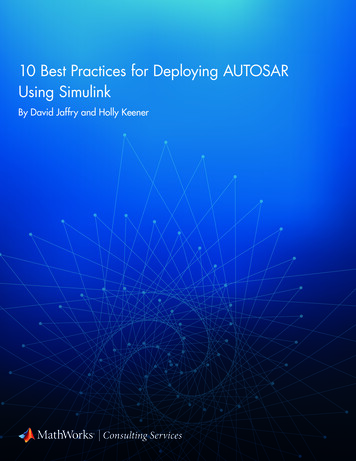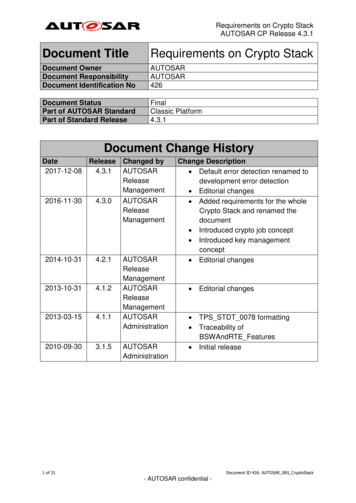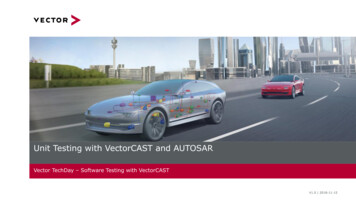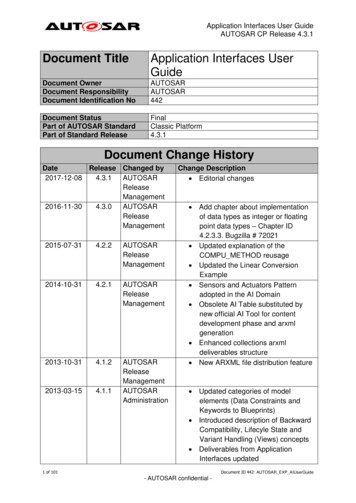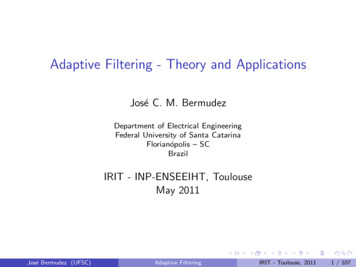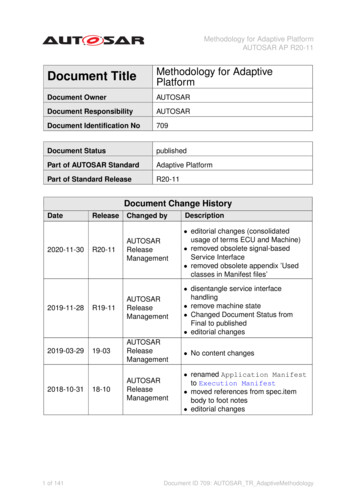
Transcription
Methodology for Adaptive PlatformAUTOSAR AP R20-11Document TitleMethodology for AdaptivePlatformDocument OwnerAUTOSARDocument ResponsibilityAUTOSARDocument Identification No709Document StatuspublishedPart of AUTOSAR StandardAdaptive PlatformPart of Standard ReleaseR20-11Document Change 11 of 141Changed byDescriptionAUTOSARReleaseManagement editorial changes (consolidatedusage of terms ECU and Machine) removed obsolete signal-basedService Interface removed obsolete appendix ’Usedclasses in Manifest files’R19-11AUTOSARReleaseManagement disentangle service interfacehandling remove machine state Changed Document Status fromFinal to published editorial changes19-03AUTOSARReleaseManagement No content changes18-10AUTOSARReleaseManagement renamed Application Manifestto Execution Manifest moved references from spec.itembody to foot notes editorial changesReleaseR20-11Document ID 709: AUTOSAR TR AdaptiveMethodology
Methodology for Adaptive PlatformAUTOSAR AP R20-112018-03-292017-10-272017-03-312 of 141AUTOSARReleaseManagement Split of machine design and machineconfiguration Added diagnostic mapping Added roles Reviewed sections about deploymentof Software Packages17-10AUTOSARReleaseManagement Design of service orientedcommunication between CP and AP Design of signal orientedcommunication between CP and AP Deployment by means ofSoftwareCluster Removed concept of easeManagement Initial release18-03Document ID 709: AUTOSAR TR AdaptiveMethodology
Methodology for Adaptive PlatformAUTOSAR AP R20-11DisclaimerThis work (specification and/or software implementation) and the material contained init, as released by AUTOSAR, is for the purpose of information only. AUTOSAR and thecompanies that have contributed to it shall not be liable for any use of the work.The material contained in this work is protected by copyright and other types of intellectual property rights. The commercial exploitation of the material contained in thiswork requires a license to such intellectual property rights.This work may be utilized or reproduced without any modification, in any form or byany means, for informational purposes only. For any other purpose, no part of the workmay be utilized or reproduced, in any form or by any means, without permission inwriting from the publisher.The work has been developed for automotive applications only. It has neither beendeveloped, nor tested for non-automotive applications.The word AUTOSAR and the AUTOSAR logo are registered trademarks.3 of 141Document ID 709: AUTOSAR TR AdaptiveMethodology
Methodology for Adaptive PlatformAUTOSAR AP R20-11Table of Contents1 Introduction1.11.21.31.41.51.61.7Objective and Scope . . .Document Outline . . . . .Document Conventions . .Abbreviations . . . . . . .Methodology Concepts . .Requirements TraceabilityKnown Limitations . . . .12.2 Use Cases for the Adaptive Platform2.1Overall View . . . . . . . . . . . . . . . . . . . . . . . . . . . . . . . . .2.1.1Purpose . . . . . . . . . . . . . . . . . . . . . . . . . . . . .2.1.2Description . . . . . . . . . . . . . . . . . . . . . . . . . . . .2.1.2.1Domains of Development . . . . . . . . . . . . . . .2.1.2.2Fundamental Activities . . . . . . . . . . . . . . . . .2.1.2.3Workflow . . . . . . . . . . . . . . . . . . . . . . . .2.2Architecture and Design . . . . . . . . . . . . . . . . . . . . . . . . . .2.2.1Develop a Service Interface Description . . . . . . . . . . . .2.2.1.1Purpose . . . . . . . . . . . . . . . . . . . . . . . . .2.2.1.2Description . . . . . . . . . . . . . . . . . . . . . . .2.2.1.3Workflow . . . . . . . . . . . . . . . . . . . . . . . .2.2.2Design communication between Classic Platform andAdaptive Platform . . . . . . . . . . . . . . . . . . . . .2.2.2.1Design service oriented communication betweenClassic Platform and Adaptive Platform .2.2.2.2Design signal oriented communication betweenClassic Platform and Adaptive Platform . . . . . . .2.2.3Develop the communication structure by means of MachineDesign . . . . . . . . . . . . . . . . . . . . . . . . . . . . . .2.2.3.1Purpose . . . . . . . . . . . . . . . . . . . . . . . . .2.2.3.2Description . . . . . . . . . . . . . . . . . . . . . . .2.2.3.3Workflow . . . . . . . . . . . . . . . . . . . . . . . .2.2.4Create a Diagnostic Mapping . . . . . . . . . . . . . . . . . .2.2.4.1Purpose . . . . . . . . . . . . . . . . . . . . . . . . .2.2.4.2Description . . . . . . . . . . . . . . . . . . . . . . .2.2.4.3Workflow . . . . . . . . . . . . . . . . . . . . . . . .2.3Software Development . . . . . . . . . . . . . . . . . . . . . . . . . . .2.3.1Develop Adaptive Application Software . . . . . . . . . . . .2.3.1.1Purpose . . . . . . . . . . . . . . . . . . . . . . . . .2.3.1.2Description . . . . . . . . . . . . . . . . . . . . . . .2.3.1.3Workflow . . . . . . . . . . . . . . . . . . . . . . . .2.3.2Develop Adaptive Platform-level Software . . . . . . . . . . .2.3.2.1Purpose . . . . . . . . . . . . . . . . . . . . . . . . .2.3.2.2Description . . . . . . . . . . . . . . . . . . . . . . .4 of 83839404040424444444445474748Document ID 709: AUTOSAR TR AdaptiveMethodology
Methodology for Adaptive PlatformAUTOSAR AP R20-112.42.3.2.3Workflow . . . . . . . . . . . . .Integration and Deployment . . . . . . . . . . . . .2.4.1Integrate Software . . . . . . . . . . . . .2.4.1.1Purpose . . . . . . . . . . . . . .2.4.1.2Description . . . . . . . . . . . .2.4.1.3Workflow . . . . . . . . . . . . .2.4.2Define and configure a Machine . . . . .2.4.2.1Preparatory steps . . . . . . . . .2.4.2.2Configure the Machine . . . . . .2.4.3Create Execution Manifest . . . . . . . .2.4.3.1Purpose . . . . . . . . . . . . . .2.4.3.2Description . . . . . . . . . . . .2.4.3.3Workflow . . . . . . . . . . . . .2.4.4Define and Configure Service Instances .2.4.4.1Purpose . . . . . . . . . . . . . .2.4.4.2Description . . . . . . . . . . . .2.4.4.3Workflow . . . . . . . . . . . . .2.4.5Set up an initial Machine . . . . . . . . .2.4.5.1Purpose . . . . . . . . . . . . . .2.4.5.2Description . . . . . . . . . . . .2.4.5.3Workflow . . . . . . . . . . . . .2.4.6Create Software Packages . . . . . .2.4.6.1Purpose . . . . . . . . . . . . . .2.4.6.2Description . . . . . . . . . . . .2.4.6.3Workflow . . . . . . . . . . . . .2.4.7Management and provision of Software2.4.7.1Purpose . . . . . . . . . . . . . .2.4.7.2Description . . . . . . . . . . . .2.4.7.3Workflow . . . . . . . . . . . . . . . . . . . . . . . . . . . . . . . . . . . . . . . . . . . . . . . . . . . . . . . . . . . . . . . . . . . . . . . . . . . . . . . . . . . . . . . . . . . . . . . . . . . . . . . . . . . . . . . . . . . . . . . . . . . . . . . . . . . . . . . . . . . . . . . . . . . . . . . . . . . . . . . . . . .Packages. . . . . . . . . . . . . . . . . . .3 Adaptive Methodology Library3.176Roles . . . . . . . . . . . . . . . . . . . . . . . . . . . . . . .3.1.1OEM . . . . . . . . . . . . . . . . . . . . . . . . .3.1.2Tier 1 . . . . . . . . . . . . . . . . . . . . . . . . .3.1.3Tier 2 . . . . . . . . . . . . . . . . . . . . . . . . .3.2High Level Architecture . . . . . . . . . . . . . . . . . . . . .3.2.1Tasks . . . . . . . . . . . . . . . . . . . . . . . . .3.2.1.1Develop Adaptive Software . . . . . . . .3.2.1.2Develop a Common Software Architecture3.2.1.3Develop a Function Architecture . . . . .3.2.2Work Products . . . . . . . . . . . . . . . . . . . .3.2.2.1Abstract System Description . . . . . . . .3.2.2.2Adaptive Software . . . . . . . . . . . . .3.2.2.3Common Software Architecture . . . . . .3.2.2.4Function Architecture . . . . . . . . . . . .3.2.2.5System Description . . . . . . . . . . . . .5 of 67073737374.767676777878787878797979808080Document ID 709: AUTOSAR TR AdaptiveMethodology
Methodology for Adaptive PlatformAUTOSAR AP R20-113.3Service Interface . . . . . . . . . . . . . . . . . . . . . . . . . . . . . .3.3.1Tasks . . . . . . . . . . . . . . . . . . . . . . . . . . . . . . .3.3.1.1Provide Data Types for Adaptive Platform . . . . . .3.3.1.2Define Service Interfaces . . . . . . . . . . . . . . .3.3.1.3Aggregate Service Interfaces . . . . . . . . . . . . .3.3.2Work Products . . . . . . . . . . . . . . . . . . . . . . . . . .3.3.2.1AUTOSAR AP Standard Package . . . . . . . . . . .3.3.2.2AP Data Types . . . . . . . . . . . . . . . . . . . . .3.3.2.3Service Interface Description . . . . . . . . . . . . .3.3.2.4Service Interface Mapping . . . . . . . . . . . . . . .3.4Communication Mapping . . . . . . . . . . . . . . . . . . . . . . . . . .3.4.1Tasks . . . . . . . . . . . . . . . . . . . . . . . . . . . . . . .3.4.1.1Map Method . . . . . . . . . . . . . . . . . . . . . . .3.4.1.2Map Event . . . . . . . . . . . . . . . . . . . . . . . .3.4.1.3Map Field . . . . . . . . . . . . . . . . . . . . . . . .3.4.1.4Map Fire and Forget . . . . . . . . . . . . . . . . . .3.4.1.5Map SignalBasedMethod to ISignalTriggerings . . .3.4.1.6Map SignalBasedEvent to ISignalTriggerings . . . .3.4.1.7Map SignalBasedField to ISignalTriggerings . . . . .3.4.1.8Map ServiceInstance to PortPrototype . . . . . . . .3.4.2Work Products . . . . . . . . . . . . . . . . . . . . . . . . . .3.4.2.1Client Server Interface Description . . . . . . . . . .3.4.2.2Sender Receiver Interface Description . . . . . . . .3.4.2.3Trigger Interface Description . . . . . . . . . . . . . .3.4.2.4Service Interface Mapping Set . . . . . . . . . . . .3.4.2.5Service Interface Mapping for Service OrientedCommunication . . . . . . . . . . . . . . . . . . . . .3.4.2.6Service Instance To Signal Mapping Set . . . . . . .3.4.2.7Service Instance To Signal Mapping . . . . . . . . .3.5Machine Design . . . . . . . . . . . . . . . . . . . . . . . . . . . . . . .3.5.1Tasks . . . . . . . . . . . . . . . . . . . . . . . . . . . . . . .3.5.1.1Define and configure the network connections of aMachine . . . . . . . . . . . . . . . . . . . . . . . . .3.5.1.2Configure the Service Discovery Message Exchange3.5.2Work Products . . . . . . . . . . . . . . . . . . . . . . . . . .3.5.2.1Machine Design . . . . . . . . . . . . . . . . . . . .3.6Diagnostic Mapping . . . . . . . . . . . . . . . . . . . . . . . . . . . . .3.6.1Tasks . . . . . . . . . . . . . . . . . . . . . . . . . . . . . . .3.6.1.1Associate Diagnostic Mapping with Process Design3.6.1.2Map Diagnostic Clear Condition to Port(s) . . . . . .3.6.1.3Map Diagnostic Data . . . . . . . . . . . . . . . . . .3.6.1.4Map Diagnostic Enable Condition to Ports . . . . . .3.6.1.5Map Diagnostic Event to Port(s) . . . . . . . . . . . .3.6.1.6Map Diagnostic Indicator to Port(s) . . . . . . . . . .3.6.1.7Map Diagnostic Generic UDS Service Handler toPort(s) . . . . . . . . . . . . . . . . . . . . . . . . . .6 of 090919191929292929393939393949495959696Document ID 709: AUTOSAR TR AdaptiveMethodology
Methodology for Adaptive PlatformAUTOSAR AP R20-113.6.1.8Map Diagnostic Memory Destination to Port(s) . . . 963.6.1.9Map Diagnostic Operation Cycle to Port(s) . . . . . . 973.6.1.10Map Diagnostic Security Level to Port(s) . . . . . . . 973.6.1.11Map Diagnostic Service Data Identifier to Port(s) . . 983.6.1.12Map Diagnostic Storage Condition to Port(s) . . . . . 983.6.1.13Map Diagnostic Upload/Download to Port(s) . . . . . 983.6.2Work Products . . . . . . . . . . . . . . . . . . . . . . . . . . 993.6.2.1Diagnostic Machine Extract . . . . . . . . . . . . . . 993.6.2.2DID . . . . . . . . . . . . . . . . . . . . . . . . . . . 1003.6.2.3Diagnostic Enable Condition . . . . . . . . . . . . . . 1013.6.2.4Diagnostic Event . . . . . . . . . . . . . . . . . . . . 1013.6.2.5Diagnostic Mapping . . . . . . . . . . . . . . . . . . 1013.6.2.6Diagnostic Operation Cycle . . . . . . . . . . . . . . 1023.6.2.7Diagnostic Storage Condition . . . . . . . . . . . . . 1033.7Adaptive Software . . . . . . . . . . . . . . . . . . . . . . . . . . . . . 1033.7.1Tasks . . . . . . . . . . . . . . . . . . . . . . . . . . . . . . . 1033.7.1.1Generate Header Files for Service Interfaces . . . . 1033.7.1.2Design Software Component for Adaptive Platform . 1043.7.1.3Implement Software Component Functionality . . . . 1043.7.1.4Compile Software Component . . . . . . . . . . . . . 1053.7.1.5Develop Main Function . . . . . . . . . . . . . . . . . 1053.7.1.6Configure Serialization for Adaptive Platform . . . . 1053.7.1.7Generate Serialization Code for Adaptive Platform . 1063.7.1.8Implement Service Proxies and Skeletons . . . . . . 1063.7.1.9Build (Adaptive) Executable . . . . . . . . . . . . . . 1073.7.2Work Products . . . . . . . . . . . . . . . . . . . . . . . . . . 1073.7.2.1Build Chain Configuration . . . . . . . . . . . . . . . 1073.7.2.2Header Files for Service Interfaces . . . . . . . . . . 1073.7.2.3(Adaptive) Executable . . . . . . . . . . . . . . . . . 1083.7.2.4Implemented Service Proxies and Skeletons . . . . 1093.7.2.5Main Function . . . . . . . . . . . . . . . . . . . . . . 1093.7.2.6Serialization Configuration for Adaptive Platform . . 1093.7.2.7Serialization Source Code . . . . . . . . . . . . . . . 1103.7.2.8Software Component Description for Adaptive Platform1103.7.2.9Software Component Object Code . . . . . . . . . . 1113.7.2.10Software Component Source Code . . . . . . . . . . 1123.8Platform and Machine . . . . . . . . . . . . . . . . . . . . . . . . . . . 1123.8.1Tasks . . . . . . . . . . . . . . . . . . . . . . . . . . . . . . . 1123.8.1.1Define ECU Resource Description . . . . . . . . . . 1123.8.1.2Describe Available HW Resources . . . . . . . . . . 1133.8.1.3Define Function Groups . . . . . . . . . . . . . . . . 1133.8.1.4Define State Timeouts . . . . . . . . . . . . . . . . . 1133.8.1.5Map Process To Machine . . . . . . . . . . . . . . . 1143.8.1.6Configure OS for Adaptive Platform . . . . . . . . . . 1143.8.1.7Configure Log and Trace module . . . . . . . . . . . 1143.8.1.8Configure DoIP . . . . . . . . . . . . . . . . . . . . . 1147 of 141Document ID 709: AUTOSAR TR AdaptiveMethodology
Methodology for Adaptive PlatformAUTOSAR AP R20-113.8.1.9Configure NM module . . . . . . . . . . . . . . . . .Work Products . . . . . . . . . . . . . . . . . . . . . . . . . .3.8.2.1Middleware Library Header Files . . . . . . . . . . .3.8.2.2Middleware Libraries . . . . . . . . . . . . . . . . . .3.8.2.3ECU Resources Description . . . . . . . . . . . . . .3.8.2.4Configured Machine on Adaptive ECU . . . . . . . .3.8.2.5Machine Manifest . . . . . . . . . . . . . . . . . . . .3.8.2.6Platform Object Code . . . . . . . . . . . . . . . . .3.8.2.7Operating System for Adaptive Platform . . . . . . .3.8.2.8Process to Machine Mapping . . . . . . . . . . . . .3.8.2.9Function Groups . . . . . . . . . . . . . . . . . . . .3.8.2.10Per State Timeouts . . . . . . . . . . . . . . . . . . .3.9Execution Manifest . . . . . . . . . . . . . . . . . . . . . . . . . . . . .3.9.1Tasks . . . . . . . . . . . . . . . . . . . . . . . . . . . . . . .3.9.1.1Define Process . . . . . . . . . . . . . . . . . . . . .3.9.1.2Define Startup Configuration . . . . . . . . . . . . .3.9.1.3Define Execution Dependencies . . . . . . . . . . .3.9.1.4Associate Process with Process Design . . . . . . .3.9.2Work Products . . . . . . . . . . . . . . . . . . . . . . . . . .3.9.2.1Execution Manifest . . . . . . . . . . . . . . . . . . .3.9.2.2Process . . . . . . . . . . . . . . . . . . . . . . . . .3.9.2.3Process Design . . . . . . . . . . . . . . . . . . . . .3.9.2.4Mode-dependent Startup Configuration . . . . . . .3.10 Service Instance . . . . . . . . . . . . . . . . . . . . . . . . . . . . . .3.10.1Tasks . . . . . . . . . . . . . . . . . . . . . . . . . . . . . . .3.10.1.1Configure Service Interface Deployment . . . . . . .3.10.1.2Define and Configure Service Instance . . . . . . . .3.10.1.3Define SOME/IP timing . . . . . . . . . . . . . . . .3.10.1.4Map Service Instance to Port Prototype . . . . . . .3.10.1.5Map Service Instance to Machine . . . . . . . . . . .3.10.2Work Products . . . . . . . . . . . . . . . . . . . . . . . . . .3.10.2.1Service Interface Deployment Configuration . . . . .3.10.2.2Service Instance Configuration . . . . . . . . . . . .3.10.2.3Service Instance To Machine Mapping . . . . . . . .3.10.2.4Service Instance To Port Prototype Mapping . . . . .3.10.2.5Service Instance Manifest . . . . . . . . . . . . . . .3.11 Deployment . . . . . . . . . . . . . . . . . . . . . . . . . . . . . . . . .3.11.1Tasks . . . . . . . . . . . . . . . . . . . . . . . . . . . . . . .3.11.1.1Create an initial Software Package Manifest .3.11.1.2Identify necessary (software) artifacts . . . . . . . .3.11.1.3Collect belonging (software) artifacts of Sub Software Clusters . . . . . . . . . . . . . . . . . . . . . .3.11.1.4Model dependencies between Software Clusters . .3.11.1.5Create installation instructions . . . . . . . . . . . . .3.11.2Work Products . . . . . . . . . . . . . . . . . . . . . . . . . .3.11.2.1Software Cluster Design . . . . . . . . . . . . . . . .3.8.28 of 26126126127128128128128129129130130130Document ID 709: AUTOSAR TR AdaptiveMethodology
Methodology for Adaptive PlatformAUTOSAR AP .2.7Software Package . . . . . .Software Cluster . . . . . . .Software Package Manifest .(Sub) Software Cluster GroupUploadable Design Artifacts .Back-end server . . . . . . .A Change HistoryA.1A.2A.3A.4A.5A.6A.79 of 141131132132133133134135Change History for AP R20-11 . . . . . . . . . . .A.1.1Added Constraints in R20-11 . . . . . . .A.1.2Changed Constraints in R20-11 . . . . .A.1.3Deleted Constraints in R20-11 . . . . . .A.1.4Added Traceables in R20-11 . . . . . . .A.1.5Changed Traceables in R20-11 . . . . . .A.1.6Deleted Traceables in R20-11 . . . . . .Change History for AP R19-11 . . . . . . . . . . .A.2.1Added Constraints in R19-11 . . . . . . .A.2.2Changed Constraints in R19-11 . . . . .A.2.3Deleted Constraints in R19-11 . . . . . .A.2.4Added Traceables in R19-11 . . . . . . .A.2.5Changed Traceables in R19-11 . . . . . .A.2.6Deleted Traceables in R19-11 . . . . . .Change History for AP 19-03 . . . . . . . . . . . .A.3.1Added Constraints in 19-03 . . . . . . . .A.3.2Changed Constraints in 19-03 . . . . . .A.3.3Deleted Constraints in 19-03 . . . . . . .A.3.4Added Traceables in 19-03 . . . . . . . .A.3.5Changed Traceables in 19-03 . . . . . . .A.3.6Deleted Traceables in 19-03 . . . . . . .Change History for AP 18-10 . . . . . . . . . . . .A.4.1Added Constraints in 18-10 . . . . . . . .A.4.2Changed Constraints in 18-10 . . . . . .A.4.3Deleted Constraints in 18-10 . . . . . . .A.4.4Added Traceables in 18-10 . . . . . . . .A.4.5Changed Traceables in 18-10 . . . . . . .A.4.6Deleted Traceables in 18-10 . . . . . . .Change History for AP 18-03 . . . . . . . . . . . .A.5.1Added Specification Items in AP 18-03 .A.5.2Changed Specification Items in AP 18-03A.5.3Deleted Specification Items in AP 18-03 .Change History for AP 17-10 . . . . . . . . . . . .A.6.1Added Specification Items in AP 17-10 .A.6.2Changed Specification Items in AP 17-10A.6.3Deleted Specification Items in AP 17-10 .Change History for AP 17-03 . . . . . . . . . . . .A.7.1Added Specification Items in AP 17-03 140140140140140Document ID 709: AUTOSAR TR AdaptiveMethodology
Methodology for Adaptive PlatformAUTOSAR AP R20-11A.7.2A.7.310 of 141Changed Specification Items in AP 17-03 . . . . . . . . . . . 141Deleted Specification Items in AP 17-03 . . . . . . . . . . . . 141Document ID 709: AUTOSAR TR AdaptiveMethodology
Methodology for Adaptive PlatformAUTOSAR AP R20-11References[1] MethodologyAUTOSAR TR Methodology[2] Requirements on MethodologyAUTOSAR RS Methodology[3] Standardization TemplateAUTOSAR TPS StandardizationTemplate[4] GlossaryAUTOSAR TR Glossary[5] Software Process Engineering Meta-Model Specificationhttp://www.omg.org/spec/SPEM/2.0/[6] Software Component TemplateAUTOSAR TPS SoftwareComponentTemplate[7] Specification of ManifestAUTOSAR TPS ManifestSpecification[8] Specification of ECU Resource TemplateAUTOSAR TPS ECUResourceTemplate[9] Specification of Update and Configuration ManagementAUTOSAR SWS UpdateAndConfigManagement11 of 141Document ID 709: AUTOSAR TR AdaptiveMethodology
Methodology for Adaptive PlatformAUTOSAR AP R20-1111.1IntroductionObjective and ScopeAUTOSAR requires a common technical approach for at least the major developmentsteps, called the AUTOSAR methodology.The methodology for the AUTOSAR Classic Platform is given by [1], whereas thisdocument defines the methodology for the AUTOSAR Adaptive Platform.The corresponding requirements are defined in [2].The present expansion was necessary, because the AUTOSAR Adaptive Platform hasintroduced new concepts.In contrast to the AUTOSAR Classic Platform, instances of Adaptive Software, areexecuted within the context of processes (which are entities managed by the operatingsystem). If permitted by the configuration of the operating system, processes may bestarted, executed or stopped, at any time during the life cycle of a Machine. As aconsequence, the way of configuration (by the means of Manifests) or when andhow software packages are deployed (e.g., by software updates over-the-air) clearlydiffer from the concepts of the AUTOSAR Classic Platform.Moreover, the term Machine has been newly introduced with the AUTOSAR AdaptivePlatform. A Machine is quasi a virtualized ECU-HW, an entity where software can bedeployed to. In this spirit, one real ECU-HW could run several Machines, even thoughthe methodology will not detail this. In the simplest case the term Machine may onlybe a synonym for ECU-HW.Although the list is not complete, aforementioned aspects may serve as sufficient motivation to provide a separate methodology for the AUTOSAR Adaptive Platform.Despite all the differences, there are also many commonalities, such as the descriptionof the system features, like topologies or hardware capabilities. This document, however, will rather focus on the specifics of the AUTOSAR Adaptive platform, in order toavoid duplications. The specification of the common aspects of both platforms may bethe subject of a separate document (foundation document) later.[TR AMETH 00100] Scope of the Methodology for the AUTOSAR Adaptive Platform dThe methodology for the AUTOSAR Adaptive Platform describes main aspects(use-cases, tasks, work products, .) necessary to build an Adaptive AUTOSAR system and how they relate to each other. However, the methodology does neither providea complete process description, nor does it stipulate a precise order of activities. Iterations of activities are possible, but it is not described how and when iterations shall becarried out.c(RS METH 00006, RS METH 00020, RS METH 00056)12 of 141Document ID 709: AUTOSAR TR AdaptiveMethodology
Methodology for Adaptive PlatformAUTOSAR AP R20-111.2Document OutlineThis document will follow the policies of the AUTOSAR Classic Platform, i.e., the wayhow to model use-cases, how to structure the document and the way to specify.Thus, the outline of this document follows roughly its counterpart of the AUTOSARClassic Platform:The rest of this section documents the policies utilized and the requirements traceabilitymap.Section 2 describes the major use cases for the development of a system implementing an AUTOSAR Adaptive Platform. Note that the description of the life cycle of aSoftware Package is not included in the AUTOSAR methodology.Section 3 lists and describes all tasks and work products, which are used in thedescriptions of the use cases in section 2.1.3Document ConventionsThis document follows a list of document conventions, which are described in the following.Technical terms of AUTOSAR are typeset in mono spaced font, e.g. Machine. As ageneral rule, plural forms of technical terms are created by adding "s" to the singularform, e.g. Machines.This document contains specification items in textual form that are distinguished fromthe rest of the text by a unique numerical ID, a headline, and the actual text starting afterthe d character and terminated by the c character. The conventions for requirementstraceability follow [TPS STDT 00080], see Standardization Template ([3]).1.4AbbreviationsThe following table contains a list of abbreviations used in the scope of this documentalong with the spelled-out meaning of each of the abbreviations.AbbreviationMeaningABIAPApplication Binary InterfaceAUTOSAR Adaptive PlatformApplication Programming InterfaceAPIARXMLAUTOSAR XML513 of 141Document ID 709: AUTOSAR TR AdaptiveMethodology
Methodology for Adaptive PlatformAUTOSAR AP R20-114AbbreviationMeaningCPAUTOSAR Classic PlatformTR Glossary ([4]) defines: A gateway is functionality withinan ECU that performs a frame or signal mapping function between two communication systems. Communication systemin this context means e.g. a CAN system or one channel of aFlexRay system.For clarity we use the term CP Gateway instead.Diagnostics over IPDiagnostic ManagerCP GatewayDoIPDMDTCDiagnostic Trouble CodeECUECU-HWECU-InstanceE/E systemHWIDIPJSON(Adaptive)chineManifestNMNV14 of 141Ma-AUTOSAR TR Glossary ([4]) defines: ECU Electronic Control Unit.For clarity we use the terms ECU-HW and ECU-Instance instead.We consider an Electronic Control Unit as a container for anycombination of AP and CP stacks.For this document the term ECU-HW is typically abstracted/independent from physical or virtual realization - if issues likeECU-Housing containing multiple physical ECU-HW, or physical ECU-HW providing multiple virtual ECU-HWs are of importance this is explicitly mentioned.An ECU-Instance is a single instantiation of a CP stack,is not applicable for AP andmay run on physical ECU-HW (without hypervisor) or on virtualECU-HW (with hypervisor).Electric and Electronic systemHardwareIdentifierInternet ProtocolJavaScript Object NotationA Machine is a single instantiation of an AP stack,is not applicable for CP andmay run on physical ECU-HW (without hypervisor) or on virtualECU-HW (with hypervisor).A description to specify the behavior of an AUTOSAR platformmodule or service.Network ManagementNon-Volatile5Document ID 709: AUTOSAR TR AdaptiveMethodology
Methodology for Adaptive PlatformAUTOSAR AP R20-114AbbreviationMeaningOEMOriginal Equipment ManufacturerOSOperating SystemPHMPlatform Health ManagementPortInterfacePOSIXAn AUTOSAR interface that is used an AUTOSAR SoftwareComponent.Portable Operating System InterfaceSDSOME/IPSWCTCPTLVUCMService DiscoveryScalable service-Oriented MiddlewarE over IPSoftware ComponentTransport Control ProtocolTag Length ValueUDSUDPUMLUnified Diagnostic ServicesUser datagram ProtocolUUIDVFBXMLXSDUniversally Unique IdentifierVirtual Functional BusExtensible Markup LanguageUpdate and Configuration ManagementUnified Modeling LanguageXML Schema DefinitionTable 1.1: Abbreviations used in the scope of this Document1.5Methodology ConceptsThe concepts of the methodology for the Adaptive Platform are identical with the concepts of the methodology for the Classic Platform. Hence, we will only mention themain principles here. Please refer to section 1.5 in [1] for further details.[TR AMETH 00101] Definition of tasks, work products and use cases dThemethodology describes typical use cases by means of activitys, entities to aggregate tasks and their corresponding work products. Tasks are defined as reusableelements: input information (e.g., stored within particular work products) is processed in order to generate new work products.c(RS METH 00018) 1[TR AMETH 00102] Types and kinds of work products dWork products are either artifacts or deliverables and can be of the kind AUTOSAR XML, sourcecode, object code, executable, text or custom.c(RS METH 00018)1This document describes use cases in Section 2, tasks and work products in Section 3.15 of 141Document ID 709: AUTOSAR TR AdaptiveMethodology
Methodology for Adaptive PlatformAUTOSAR AP R20-11[TR AMETH 00226] Documentation of work products dIn order to document designdecisions or restrictions during the development process, each work product mayaggregate a corresponding documentation.c(RS METH 00069)The definitions and the figures are made according to the Software Process Engineering Meta-Model Specification (SPEM) [5]. The symbols are those used by theEnterprise Architect modeling tool.1.6Requirements TraceabilityThe following table references the requirements specified in the corresponding requirements document [2].Requirement[RS METH 00006][RS METH 00015][RS METH 00016][RS METH 00018][RS METH 00020][RS METH 00032]DescriptionThe methodology shall explainhow to build an AUTOSARsystemThe methodology shall beindependent of programminglanguagesThe methodology shall supportbuilding a system of bothAUTOSAR and Non-AUTOSARECUsThe methodology sha
Methodology for Adaptive Platform AUTOSAR AP R20-11 2018-03-29 18-03 AUTOSAR Release
